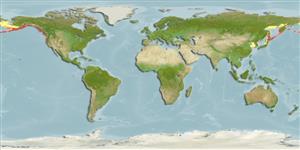Environment: milieu / climate zone / depth range / distribution range
Ökologie
seewasser demersal; tiefenbereich 0 - 150 m (Ref. 50550). Temperate; 66°N - 34°N
North Pacific: Sea of Japan to the Bering Sea and to San Simeon, central California, USA.
Size / Gewicht / Alter
Maturity: Lm ? range ? - ? cm
Max length : 20.0 cm SL Männchen/unbestimmt; (Ref. 559)
Rückenflossenstacheln (insgesamt) : 6 - 9; Rückenflossenweichstrahlen (insgesamt) : 20 - 25; Afterflossenstacheln: 0; Afterflossenweichstrahlen: 18 - 21. Caudal fin rounded. Pelvic fins small.
Occurs in intertidal areas and to 37 m depth, but more common in subtidal areas (Ref. 2850). Often found among algae (Ref. 2850). Adults inject eggs into the tissue near the gastral cavity of a sponge to use as a spawning bed (Ref. 34818).
External fertilization with internal insemination (Ref. 37516). Adults inject eggs into the tissue near the gastral cavity of a sponge to use as a spawning bed (Ref. 34818).
Eschmeyer, W.N., E.S. Herald and H. Hammann, 1983. A field guide to Pacific coast fishes of North America. Boston (MA, USA): Houghton Mifflin Company. xii+336 p. (Ref. 2850)
IUCN Rote Liste Status (Ref. 130435: Version 2024-1)
Bedrohung für Menschen
Harmless
Nutzung durch Menschen
Sportfisch: ja
Tools
Zusatzinformationen
Download XML
Internet Quellen
Estimates based on models
Preferred temperature (Ref.
123201): 2.9 - 14, mean 7.1 °C (based on 520 cells).
Phylogenetic diversity index (Ref.
82804): PD
50 = 0.7539 [Uniqueness, from 0.5 = low to 2.0 = high].
Bayesian length-weight: a=0.00631 (0.00334 - 0.01192), b=3.14 (2.96 - 3.32), in cm total length, based on LWR estimates for this species & (Sub)family-body (Ref.
93245).
Trophic level (Ref.
69278): 3.3 ±0.5 se; based on diet studies.
Generation time: 3.3 ( na - na) years. Estimated as median ln(3)/K based on 1
growth studies.
Widerstandsfähigkeit (Ref.
120179): mittel, Verdopplung der Population dauert 1,4 - 4,4 Jahre. (Fec=234-404).
Fishing Vulnerability (Ref.
59153): Low to moderate vulnerability (32 of 100).
